 EXPLORING PUBLIC ART PRACTICES, 2016 Vimeo. Kenneth Rainin Foundation
EXPLORING PUBLIC ART PRACTICES, 2016 Vimeo. Kenneth Rainin Foundation
CALIFORNIA ARTIST MILDRED HOWARD draws on African American family, community, and cultural history to develop multi-layered installations based on the power of memory to reveal and to heal. She combines archieval materials and culturally-imprinted found domestic objects to construct spaces where an audience may enter and respond—a pattern similar to the ‘call and response’ of African-based music. She was raised to ‘remember where she came from,’ and encouraged to develop her skills and confidence through ‘making, doing, and knowing.’1
Howard( ‘s) real medium is memory, which permeates her work with vitality and poignancy. Leah Ollman, LA Times art writer/critic, Art in America (March 1998)
I. THE GREAT MIGRATIONS
IN THE UNITED STATES, there were two great voluntary African American migrations out of the Jim Crow South. The First Great Migration (1910-1940) saw some 1.5 million Blacks leave the social and economic insecurity of the agricultural South for the promise of jobs in the industrial cities of the North and Midwest. They left a thankless landscape of poverty, rigid segregation, unequal access to education, and no prospects for positive change. The Second Great Migration (1940-70) was precipated by the coming of World War II. The astronomical growth of war industries lured Southern Blacks to move not just to the North and East, but for the first time in large numbers, to the West Coast. Between 1942 to 1945 alone, 340,000 African Americans settled in California.
Included in the Second Great Migration was the Howard family of Texas—Rolly and Mable Howard, and their nine children. Early in the 1940’s they moved to San Francisco where good paying jobs in shipyards were plentiful. In the Alameda Shipyards Rolly worked as a longshoreman, and Mable became the first Black woman admitted to the Painters Union. An active unionist she paved the way for other women to join, maintaining a close relationship with the ILWU for 30+ years. Their tenth child, Mildred, was born in 1945 in San Francisco.
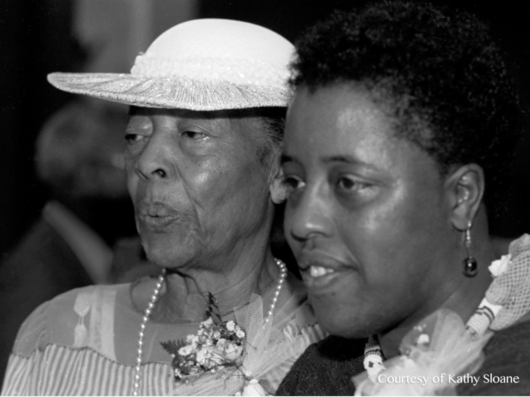 MILDRED AND MAMA HOWARD IN 1985. Photo by Kathy Sloane.
MILDRED AND MAMA HOWARD IN 1985. Photo by Kathy Sloane.
II. FAMILY FOUNDATION
IN 1947 THE FAMILY LEFT San Francisco to put down roots in what was then the diverse neighborhood of South Berkeley. Her parents ran an antiques business there and were politically active in labor unions, civil rights’ struggles and community issues.
Called ‘Mama Howard” because she nurtured so many future prominent civic leaders, Mildred’s mother Mable (1905-1994) was a highly respected activist for women’s rights and racial justice, and a beloved role model for young Mildred. Their home was a meeting place for the socially and politically minded in the area. Mama Howard is best remembered for heading community-wide efforts so that BART train tracks designed to run above ground through their neighborhood were forced underground – preventing a physical manifestation of racial segregation within Berkeley. Later, the City named a new senior housing and service center The Mable Howard Apartments in her honor; and a petition has been approved to rename the Ashby Bart Station in South Berkeley to the Mable Howard Station.
Beyond the political activity, the Howards’ antique shop became a huge influence on Mildred’s future aesthetics and choice of materials in her artworks. Every object told a story.
III. BERKELEY INCUBATOR
IN SCHOOL, MILDRED HOWARD participated in segregation protests against Berkeley schools, and belonged to the Civil Rights’ organizations, SNCC (Student Non-violent Coordinating Committee) and CORE (Congress of Racial Equality). Fond childhood memories of free community breakfasts served by the Black Panther Party were central to a temporary installation in the Oakland Museum of California.
In a 2019 public conversation on gentrification at the University of CA Berkeley Museum, Howard elaborated that, ‘As a black woman in the United States, social activism is in my DNA.’
Howard lived in Berkeley for 70 years until 2017 when gentrification forced her out. Her landlord doubled her live-in studio rent where she had lived and worked for 18 years. She now lives and works less than a mile away in Oakland.
In 2018, Mildred and her mother became the focus of filmmaker Pam Uzzell’s documentary: ‘Welcome to the Neighborhood.’ Uzzell examined the conditions surrounding an African-American family (the Howards) facing gentrification and a housing crisis that continues to threaten South Berkeley‘s diversity.
Howard talks sharply of the irony of being evicted from the neighborhood she lived in most of her life; where her family set down roots and were prominent in civic life; and where she created the artworks that made her an international art figure, all while raising twins as a single mother. Appreciative of its diversity, she said that she had originally thought she would live in the ‘People’s Republic of Berkeley’ forever. Yet, neither a 2011 Berkeley mayoral proclamation declaring ‘March 29 as Mildred Howard Day’ nor her induction in 2012 to the Alameda County Hall of Fame, could prevent this disheartening loss. It’s a too-common story among urban creatives, that despite 40+ years of major career accomplishments, she could never afford to both be an artist and to buy her own property.
IV. THE ARTIST
BEFORE BECOMING A VISUAL artist, Howard began her adult creative life as a dancer. In 1977 she received an AA Degree in Fashion Arts from the College of Alameda, and in 1985 an MFA from the Fiberworks Center for the Textile Arts of John F. Kennedy University, Orinda CA.
Fiberworks (1973-1987) was an internationally respected ‘cutting edge’ textile arts school begun in a small Berkeley workshop by Hungarian born environmental artist Gyongy Laky. Dedicated to textile as a fine art form, it fostered a broad range of interpretation and execution. It was a hotbed of creativity within its too short life. Alongside Howard, its influential faculty, lecturers and students nutured many to-be-famous artists—to name just a few, David Ireland, Nance O’Banion, Lia Cook, Ed Rossbach. While there, Executive Director Maria Vella hired Howard as a CETA worker (Comprehensive Employment of Artists Act). Vella encouraged her to present her work; and to co-curate with artist Donna Larsen an exhibit of African American art called Local Color.
Mildred Howard takes full advantage of the latitude that modernism won for artists in the use of materials and expressive idioms . Because she maneuvers so freely within the conceptually soft borders of ‘installation’ work, people tend to think of her as a sculptor, but she prefers the vaguer, more open term artist. Kenneth Baker, former Chronicle art critic San Francisco Chronicle (Feb 2007)
V. PROJECTS
IN THE EARLY 1980s, Howard’s first installations took the form of manipulated windows from storefronts and churches. They later evolved into constructed habitats that provided walk-in environments
GOSPEL AND THE STOREFRONT CHURCH (1984) performance/installation, Old Post Office, Mill Valley, Marin County CA Invited to do a participatory installation in high income, mostly white Mill Valley, Howard wanted ‘to show respect to the Marin County Blacks’ who mostly lived in the predominantly low income Marin City. She wanted to ‘bring the two cities together.’ Howard repurposed the former post office into a storefront church, using architectural salvage, found objects, painted windows, projected slides, and borrowed objects like a pulpit doily. The opening was a participatory performance where the audience was given screen-printed fans to wave while listening to the music of the Marin City Choir and Bishop Norman Williams of San Francisco’s Church of Coltrane. Howard based the work on witnessing the vital community force present in East and West Oakland storefront churches, in neighborhoods near her own in South Berkeley. In 1985 part of this installation was in an exhibit at The Museum of African American Art in Los Angeles.1
Over the course of four decades, Mildred Howard has created rich and evocative work, taking common objects of daily life and infusing them with a spark that illuminates the underlying significance and historical weight of cultural forms. In freestanding sculptures, wall- mounted musings, graphic explorations, and representations of shelter, she has developed a language to address racism, injustice, need, and compassion. What sets her work apart from much politically engaged art is its grace and elegance.2 Peter Selz (1919-2019) art historian Sculpture magazine (Dec. 2015)
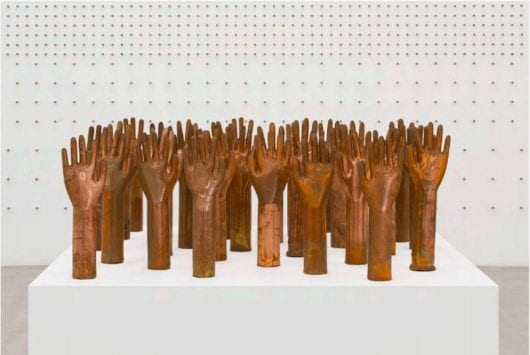 Image from Parrasch Heijnen Gallery, Los Angeles, 2020 exhibit, courtesy of Howard.
Image from Parrasch Heijnen Gallery, Los Angeles, 2020 exhibit, courtesy of Howard.
TEN LITTLE CHILDREN (ONE GOT SHOT AND THEN THERE WERE NINE), 1991, was originally installed at the San Francisco Art Institute in conjunction with Howard being honored with the Art Institute’s prestigious Adaline Kent Award. The work represented a cemetery inspired by the Soweto massacre–a series of protests led by Black school children in South Africa in 1976. Up to 176 children were killed by police.
In 1991 Howard began a long artistic journey to create an ongoing series exploring the multi-level importance of ‘home.’ Each house she created has its own central theme, as well as bringing forth her personal memories.
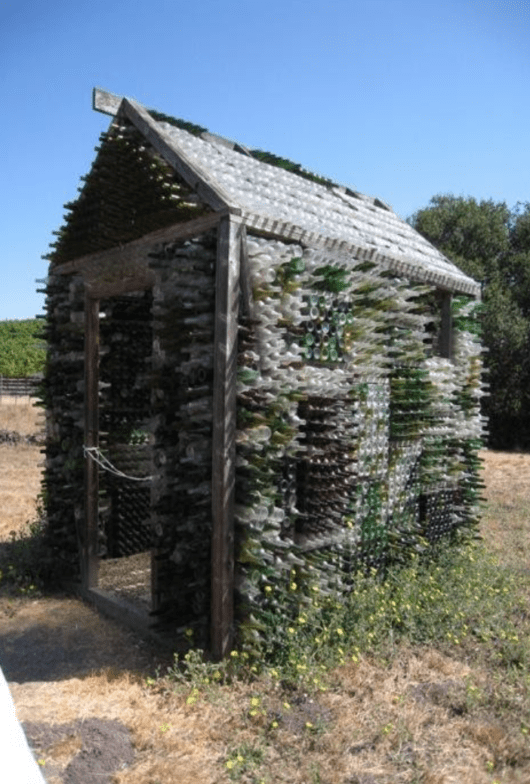
MEMORY GARDEN, PHASE I (1991) was a pivotal piece for Howard. Employing some 4,000-glass bottles of various sizes and shapes, it was the impetus for an ongoing series of bottle/glass houses for which she has become best known. She was inspired by James Weldon Johnson’s novel, An Autobiography of An Ex-Colored Man in which there is a story of a boy who grew up in a home surrounded by bottles, placed neck down into the dirt like flowers. In African cultures, bottles have represented vessels of protection when placed in front of homes. Howard’s intent was to offer a safe place of reflection.
At the time she working at the San Francisco Exploratorium, a hands-on science/art museum. There, she became interested in the physics of light and color, which inspired her strategy of combining that with found objects in her art.
She first used glass bottles in a temporary installation in the atrium of California African American Museum (CAAM) in Los Angeles. The floor was covered with sand and bottles stuck in the sand neck down, and birch trees–a direct homage to Johnson’s story.
Simultaneously (she was commuting back and forth between the Bay Area and Los Angeles) Howard created a glass bottle house at the Headland Center for the Arts, Marin County, where she was an Artist in Residence. This is the house that art collector Rene di Rosa saw and purchased for the di Rosa Preserve–217 acres in Napa County CA that he set aside for his massive collection of California art. The Preserve is now incorporated into the nonprofit di Rosa Center for Contemporary Art.
MEMORY GARDEN, PHASE II (1991), the above image. Howard rebuilt the 4,000-bottle house as a permanent installation on a bucolic hillside at the di Rosa Preserve. For this house Howard lined the interior floor with stone pavers inscribed with quotes from Johnson’s book. Recently MEMORY GARDEN has been renovated and reinstalled on a site closer to the di Rosa Center’s Main Gallery.
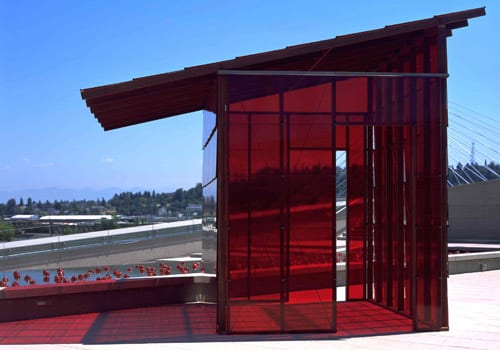
BLACK BIRD IN A RED SKY—AKA FALL OF THE BLOOD HOUSE (2005). At the Museum of Glass, International Center for Contemporary Art, Tacoma WA. While resident artist, working alongside professional glass blowers, Howard fabricated and installed a house made entirely of red glass slabs. 700 blown glass apples float in an adjacent reflection pool. This house is one of her more complex and conceptual.
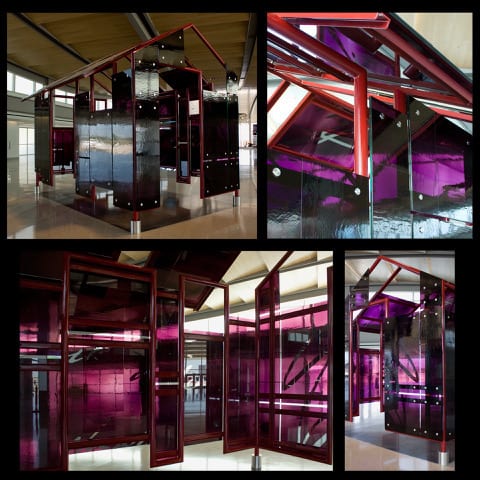
THIS HOUSE WILL NOT PASS ANY COLOR BUT ITS OWN, (2011) Palo Alto, CA. Beyond its striking color, this work’s title is among Howard’s most audacious and culturally symbolic. Built of hand-blown slabs of purple glass held aloft by cylindrical red posts sunk into the terrazzo floor, it is sized and shaped like a bus stop shelter. It refers to places of safety and shelter. Both transparent and reflective, its appearance varies in daylight. Viewers are drawn into its interior where metallic-hued strips embedded in the glass appear identical, but are not–some are transparent, others reflective. They spell out text from Gold Rush-era letters sourced from the California Historical Society. Howard was learning how to scientifically exploit the qualities of light while working at the San Francisco Exploratorium—a famous local museum dedicated to hands-on experiences to teach a broad menu of scientific principals. Howard was able to mine the information she gathered there to create more complex works. She explained: ‘It was a way of pulling the past into the future using the physics of light as a metaphor to show us what’s here and what’s gone. You see your reflection in these fragmented letters and you become part of that experience whether you know it or not.’
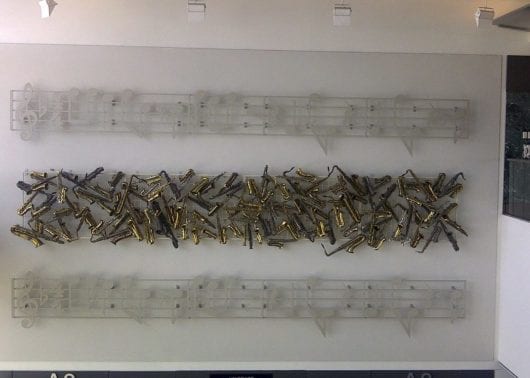
SALTY PEANUTS (2000). When the new San Francisco International Airport terminal was built, the San Francisco Art Commission gathered a stellar group of local Bay Area Artists to create large permanent installations there. Howard took the opportunity to create a wall installation of salvaged musical wind instruments framed by two lines of musical notation. Eye-catching and memorable in its place making, her sculpture is homage to Jazz great Charlie Parker who composed this famous song, ‘Salt Peanuts’ in 1949.
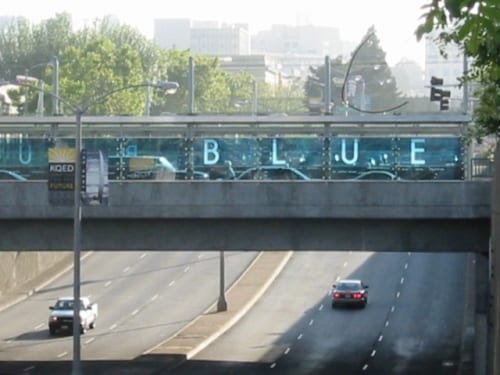
THREE SHADES OF BLUE (2003). San Francisco Art Commission in conjunction with the San Francisco Redevelopment Agency requested Howard create a public artwork to run the length of the newly constructed Fillmore Street Bridge. They specifically requested that it be made of glass, as by now Howard was becoming famous for her sculptures incorporating glass. She invited poet Quincy Troupe to collaborate with her on the project. Troupe wrote a new poem that Howard had etched over 20 panels of blue glass. The bridge connects three active historic cultural neighborhoods: ‘The Fillmore’ with its renown musical heritage, Japantown (settled there after the 1906 earthquake), and a Jewish neighborhood first settled in the late 1800’s. Troupe‘s poem celebrates all three cultures. Howard has said that this work ended up being the most disappointing, as it is the only work she has done that has been marred by graffiti.

THE MUSIC OF LANGUAGE (2008) is on the entry wall of the Glide Memorial Church’s family housing building in the Tenderloin, San Francisco’s ‘skid row.’ Glide is a cherished San Francisco institution that is ‘radically inclusive, (a) just and loving community mobilized to alleviate suffering and break the cycles of poverty and marginalization.’ A collaboration with a poet associated with Glide, Howard cast bronze letters to create sculptured words that allude to the importance of home. Her work especially underscores Glide’s message of an open welcome.
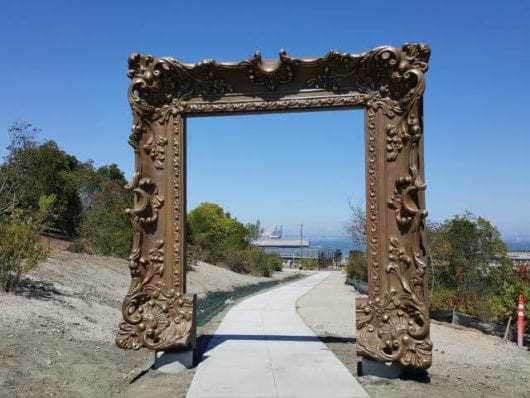
FRAME/REFRAIN (2015). Partnering with landscape architect Walter Hood on the Hunters Point Public Art Project (2012) commissioned by the SF Redevelopment Agency, Howard designed an enormous free-standing ornate symbolic golden picture frame to frame the view of the Bay waterfront and former shipyards. Created to honor the historically important Black community of Hunters Point, settled by those who moved there during the Second Great Migration to work in the shipyard. Here Howard comes full circle to also celebrate her own family’s migration story. Hood created a separate piece visible through the frame (but hard to see in this photo): tall bronze rods with disks marked how the landscape once looked historically. For Howard, these remind her of old African currency.
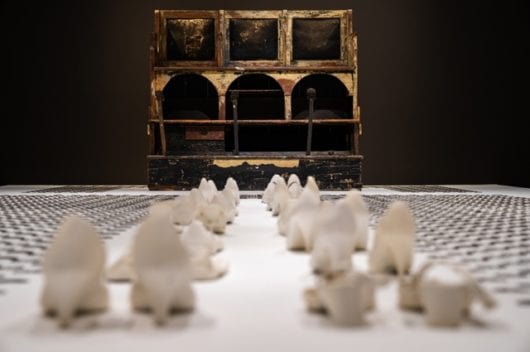
TAP: INVESTIGATION OF MEMORY (2019) Oakland Museum of California. Part of OMCA’s permanent collection, this multimedia installation examines identity, church culture, gentrification, dance, activism and more. The altar-like centerpiece is an antique shoe-shine stand from Oakland’s historic California Hotel—once a cultural center for the Black community. White shoes and metal shoe taps arranged in a pattern on the floor symbolize dance’s importance in her life.
‘Howard’s work has helped shape the narrative of activism in the Bay Area and continues to inspire artists today.’ OMCA website
VI. SOME SMALL GLASS HOUSES
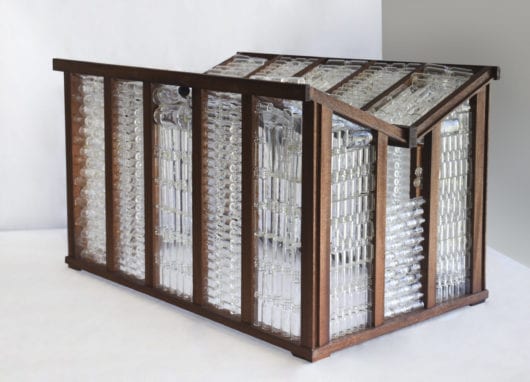
YOU ARE WELCOME HERE, Mildred Howard.
HOWARD FURTHER INVESTIGATED personal and cultural memories of home, and the effects of using different colors and shapes, in a series of smaller sized glass bottle houses set on tables or pedestals. Viewers cannot physically enter these houses, but instead look into and through the transparent walls to try to imagine who might inhabit such a dwelling and/or why.
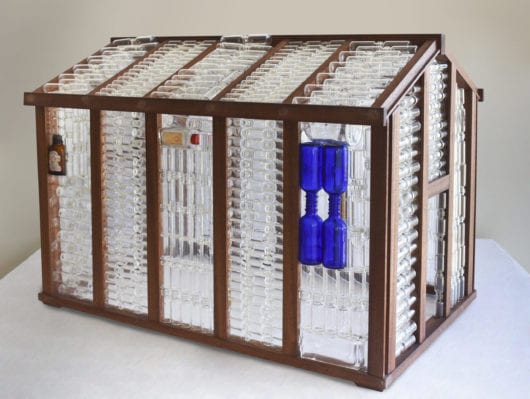 I’M HERE DO YOU SEE ME, Mildred Howard.
I’M HERE DO YOU SEE ME, Mildred Howard.
VII. PARALLEL INFLUENTIAL EXPERIENCES
IN THE LATE 1990s, celebrity chef Alice Waters selected Howard to serve as executive director of The Edible Schoolyard, Waters’ organic garden at Martin Luther King Middle School in Berkeley. It offered middle school-aged youth hands-on education in the garden and the kitchen with a focus on healthy eating and sustainable agriculture.
Howard also managed an art and communities program at the San Francisco Exploratorium, worked at Alameda County Juvenile Hall and various Bay Area jails.
She served as a cultural ambassador to Morocco, where she gave a series of lectures sponsored by the U.S. State Department.
She has taught at Stanford University, Brown University, the San Francisco Art Institute, and the California College of the Arts.
VIII. SELECTED HONORS
- SPUR Award (2012)– a prestigious honor from the San Francisco Planning and Urban Research Association. It is the City’s highest award for contributions to the arts.
- Joan Mitchell Foundation Award (2004/05)
- California Arts Council Fellowship (2003)
- Rockefeller Fellowships to Bellagio Italy (1996 and 2007)
- Lee Krasner Award for lifetime of artistic achievement (2015)
- Nancy Graves Grant for Visual Artists (2017)
- NEA Fellowship in Sculpture
- Flintridge Foundation Award for Visual Art
Large-scale installations have been mounted at Creative Time in New York, InSITE in San Diego, the National Museum of Women in the Arts, and the New Museum in New York. Public commissions and installations were executed for the Museum of Glass in Tacoma, WA, the City of Oakland, and the San Francisco Arts Commission and International Airport.
Mildred Howard’s works are represented in the collections of SFMOMA, the de Young Museum, the Berkeley Art Museum, the Museum of Contemporary Art San Diego, the Museum of Glass and Contemporary Art, Tacoma, the Oakland Museum, and the San Jose Museum of Art. Anglim Gilbert Gallery has shown Howard’s work since 1990.
Among numerous venues, her work has been shown nationally in Boston, Los Angeles and New York; internationally in Berlin, Cairo, London, Paris, and Venice; and in museums such as the Oakland Museum of California, the de Young Museum, the San Francisco Museum of Modern Art, the San Jose Museum of Art and the Museum of the African Diaspora.
RESOURCES
Editor’s note: This article was collaged together with information found in numerous articles, in Wikipedia, within talks by Mildred Howard on YouTube and Vimeo, and material provided by Howard. All photos are courtesy of Mildred Howard.
1. Steinman, Susan Leibovitz, ‘Mildred Howard’ in the Compendium of Artists; Suzanne Lacy, editor, Mapping the Terrain, New Genre Public Art , 1994, Bay Press, Seattle.
2. Baker, Kenneth, “Artist Intrigued by Interaction of Materials, Ability to Revise at Will” San Francisco Chronicle, February 9, 2007.
3. Whittaker, Richard, “This Larger Thing in the World: Conversation with Mildred Howard”, Interviews and Articles, Works & Conversations, January 28, 2000.
4. “Mildred Howard’s Blackbird in a Red Sky (a.k.a. Fall of the Blood House)”. Museum of Glass, Tacoma WA website.
5. “Glide Memorial,” Art and Architecture SF.
6. Whiting, Sam, “Berkeley’s beloved homegrown artist Mildred Howard priced out”, San Francisco Chronicle, January 6, 2017.
7. “Mildred Howard”, Joan Mitchell Foundation website.
8. Taylor, Tracey. “‘Welcome to the neighborhood’: New film shines light on a changing Berkeley”. berkeleyside.com/. Berkeleyside.
9. Selz, Peter (December 2015). “Spirit and Matter: A Conversation with Mildred Howard”. Sculpture Magazine.
10. Ollman, Leah, “Mildred Howard at Porter Troupe” Art in America, March 1998.
